BMP3005 - Applied Business Finance: Financial Management & Improvement
VerifiedAdded on 2023/06/12
|14
|3244
|52
Report
AI Summary
This report provides a comprehensive analysis of financial management, emphasizing its importance in business operations. It defines financial management, discusses key financial statements (Income Statement, Balance Sheet, Cash Flow Statement, and Statement of Changes in Equity), and explains the use of financial ratios for performance evaluation. The report includes a practical application through a case study, where financial data is analyzed to assess profitability, liquidity, and efficiency. Furthermore, it suggests processes and strategies that businesses can implement to improve their financial performance, such as enhancing asset utilization and optimizing accounts receivable collection periods. The analysis is supported by calculations and ratio interpretations, providing a clear understanding of the financial health and potential improvements for the case study organization. This student contributed the assignment to Desklib.
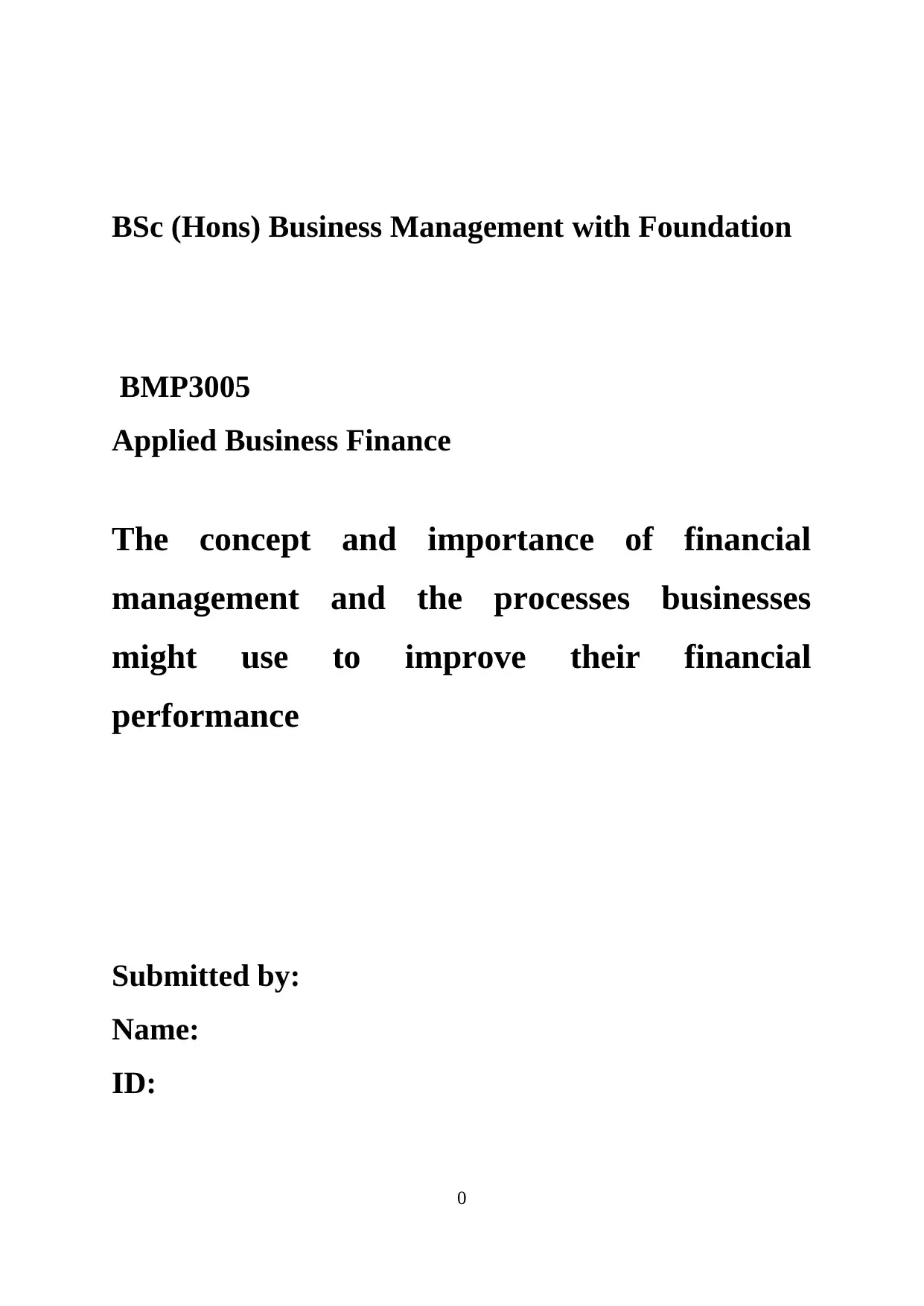
BSc (Hons) Business Management with Foundation
BMP3005
Applied Business Finance
The concept and importance of financial
management and the processes businesses
might use to improve their financial
performance
Submitted by:
Name:
ID:
0
BMP3005
Applied Business Finance
The concept and importance of financial
management and the processes businesses
might use to improve their financial
performance
Submitted by:
Name:
ID:
0
Paraphrase This Document
Need a fresh take? Get an instant paraphrase of this document with our AI Paraphraser
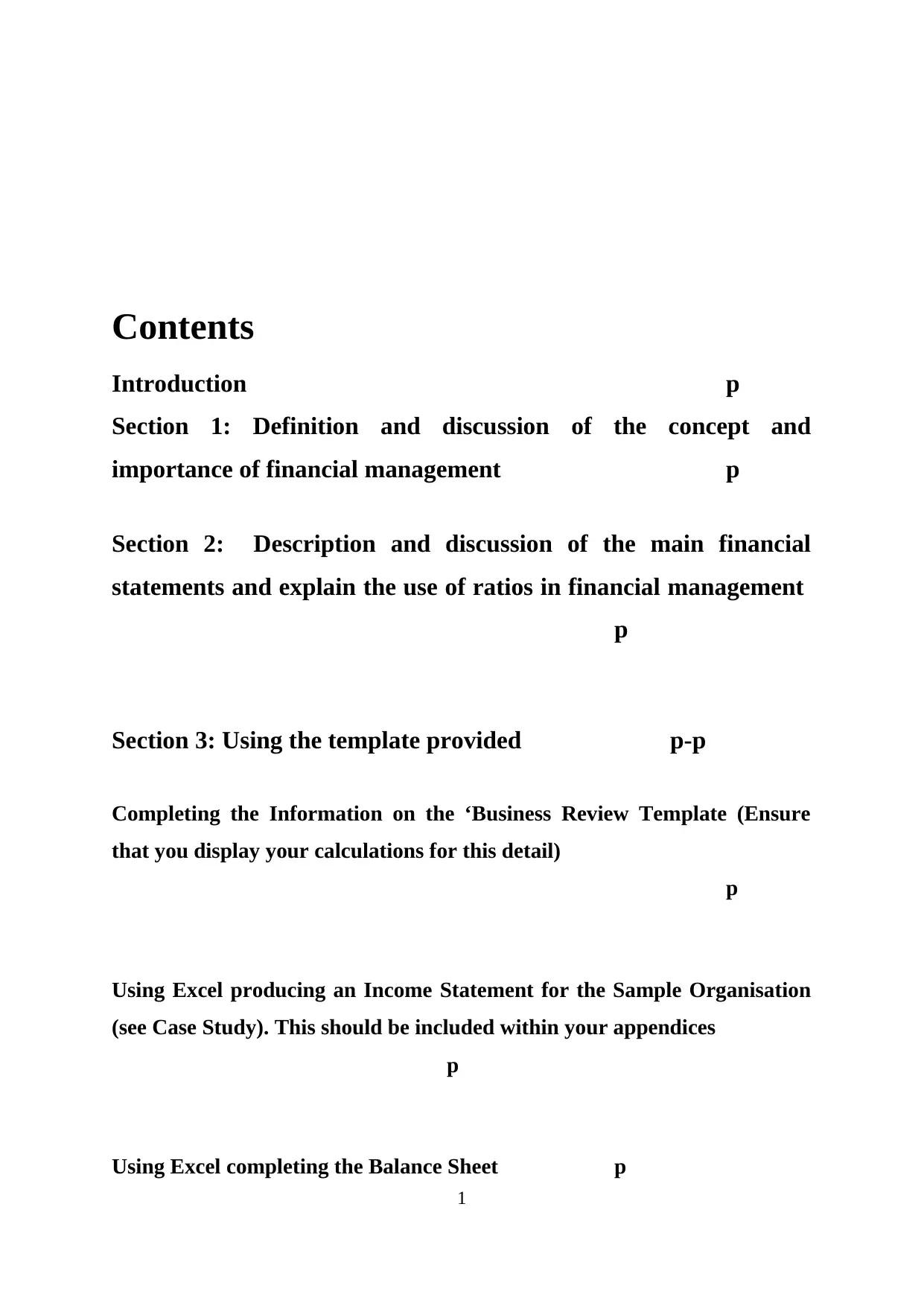
Contents
Introduction p
Section 1: Definition and discussion of the concept and
importance of financial management p
Section 2: Description and discussion of the main financial
statements and explain the use of ratios in financial management
p
Section 3: Using the template provided p-p
Completing the Information on the ‘Business Review Template (Ensure
that you display your calculations for this detail)
p
Using Excel producing an Income Statement for the Sample Organisation
(see Case Study). This should be included within your appendices
p
Using Excel completing the Balance Sheet p
1
Introduction p
Section 1: Definition and discussion of the concept and
importance of financial management p
Section 2: Description and discussion of the main financial
statements and explain the use of ratios in financial management
p
Section 3: Using the template provided p-p
Completing the Information on the ‘Business Review Template (Ensure
that you display your calculations for this detail)
p
Using Excel producing an Income Statement for the Sample Organisation
(see Case Study). This should be included within your appendices
p
Using Excel completing the Balance Sheet p
1
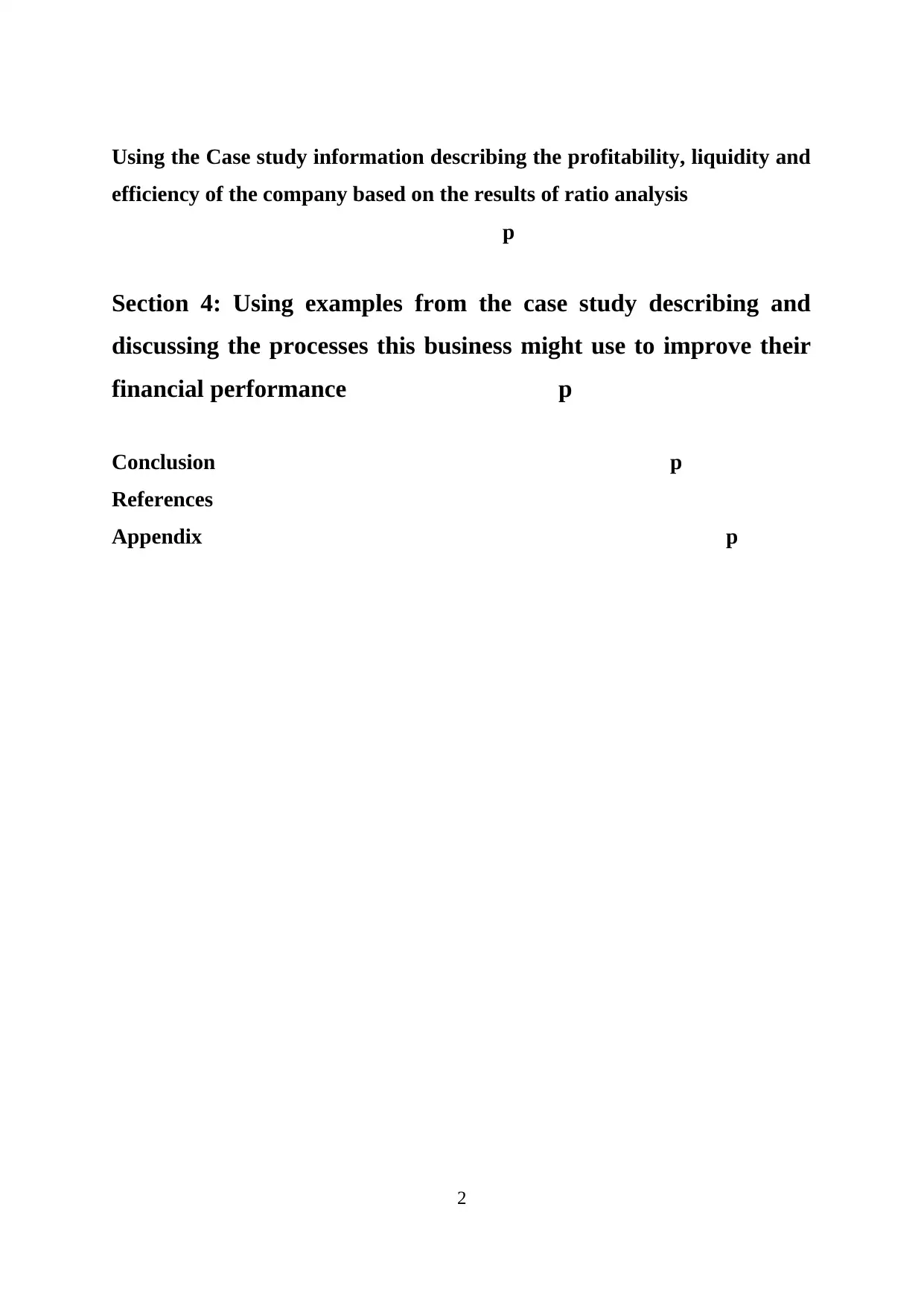
Using the Case study information describing the profitability, liquidity and
efficiency of the company based on the results of ratio analysis
p
Section 4: Using examples from the case study describing and
discussing the processes this business might use to improve their
financial performance p
Conclusion p
References
Appendix p
2
efficiency of the company based on the results of ratio analysis
p
Section 4: Using examples from the case study describing and
discussing the processes this business might use to improve their
financial performance p
Conclusion p
References
Appendix p
2
⊘ This is a preview!⊘
Do you want full access?
Subscribe today to unlock all pages.

Trusted by 1+ million students worldwide
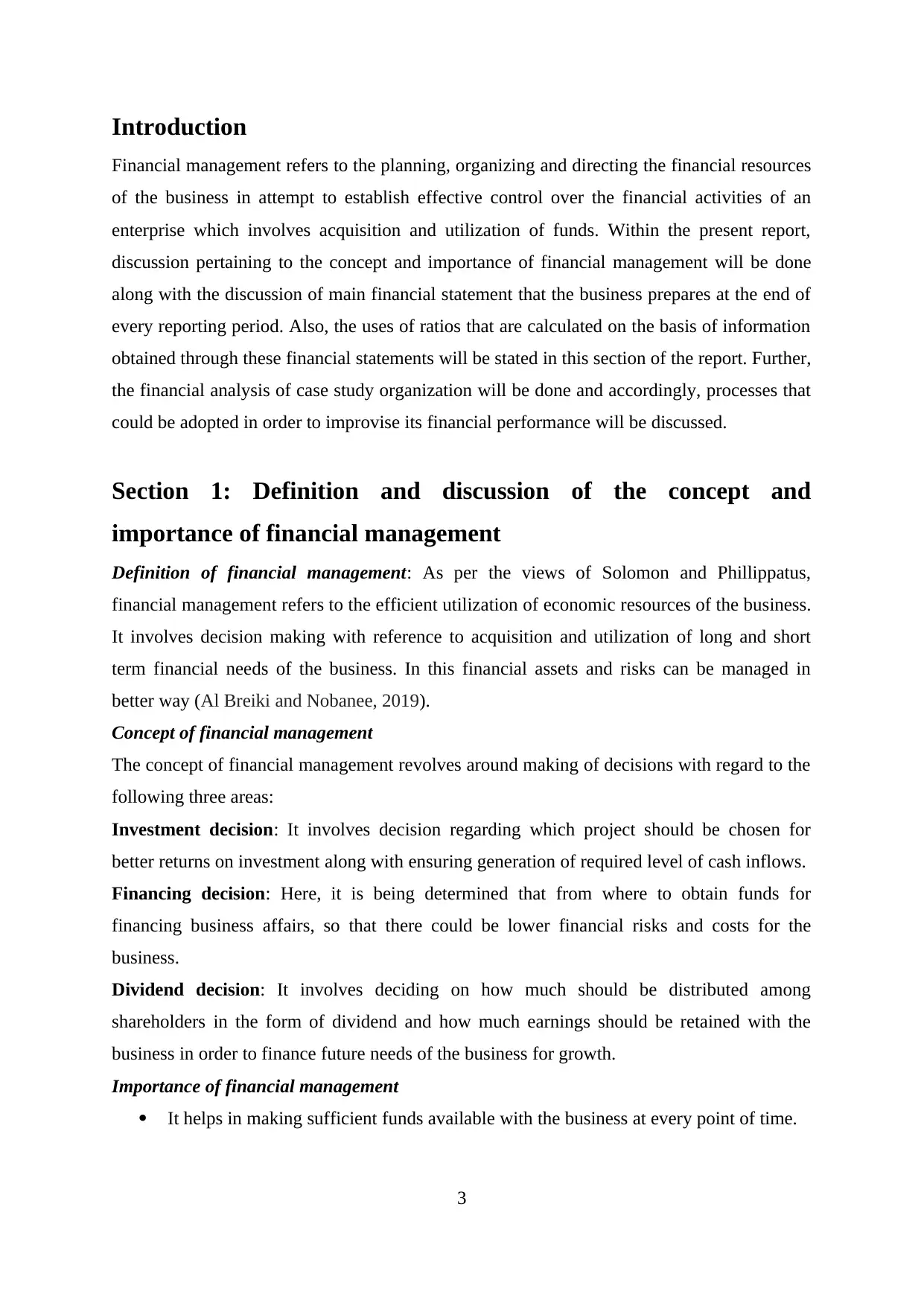
Introduction
Financial management refers to the planning, organizing and directing the financial resources
of the business in attempt to establish effective control over the financial activities of an
enterprise which involves acquisition and utilization of funds. Within the present report,
discussion pertaining to the concept and importance of financial management will be done
along with the discussion of main financial statement that the business prepares at the end of
every reporting period. Also, the uses of ratios that are calculated on the basis of information
obtained through these financial statements will be stated in this section of the report. Further,
the financial analysis of case study organization will be done and accordingly, processes that
could be adopted in order to improvise its financial performance will be discussed.
Section 1: Definition and discussion of the concept and
importance of financial management
Definition of financial management: As per the views of Solomon and Phillippatus,
financial management refers to the efficient utilization of economic resources of the business.
It involves decision making with reference to acquisition and utilization of long and short
term financial needs of the business. In this financial assets and risks can be managed in
better way (Al Breiki and Nobanee, 2019).
Concept of financial management
The concept of financial management revolves around making of decisions with regard to the
following three areas:
Investment decision: It involves decision regarding which project should be chosen for
better returns on investment along with ensuring generation of required level of cash inflows.
Financing decision: Here, it is being determined that from where to obtain funds for
financing business affairs, so that there could be lower financial risks and costs for the
business.
Dividend decision: It involves deciding on how much should be distributed among
shareholders in the form of dividend and how much earnings should be retained with the
business in order to finance future needs of the business for growth.
Importance of financial management
It helps in making sufficient funds available with the business at every point of time.
3
Financial management refers to the planning, organizing and directing the financial resources
of the business in attempt to establish effective control over the financial activities of an
enterprise which involves acquisition and utilization of funds. Within the present report,
discussion pertaining to the concept and importance of financial management will be done
along with the discussion of main financial statement that the business prepares at the end of
every reporting period. Also, the uses of ratios that are calculated on the basis of information
obtained through these financial statements will be stated in this section of the report. Further,
the financial analysis of case study organization will be done and accordingly, processes that
could be adopted in order to improvise its financial performance will be discussed.
Section 1: Definition and discussion of the concept and
importance of financial management
Definition of financial management: As per the views of Solomon and Phillippatus,
financial management refers to the efficient utilization of economic resources of the business.
It involves decision making with reference to acquisition and utilization of long and short
term financial needs of the business. In this financial assets and risks can be managed in
better way (Al Breiki and Nobanee, 2019).
Concept of financial management
The concept of financial management revolves around making of decisions with regard to the
following three areas:
Investment decision: It involves decision regarding which project should be chosen for
better returns on investment along with ensuring generation of required level of cash inflows.
Financing decision: Here, it is being determined that from where to obtain funds for
financing business affairs, so that there could be lower financial risks and costs for the
business.
Dividend decision: It involves deciding on how much should be distributed among
shareholders in the form of dividend and how much earnings should be retained with the
business in order to finance future needs of the business for growth.
Importance of financial management
It helps in making sufficient funds available with the business at every point of time.
3
Paraphrase This Document
Need a fresh take? Get an instant paraphrase of this document with our AI Paraphraser
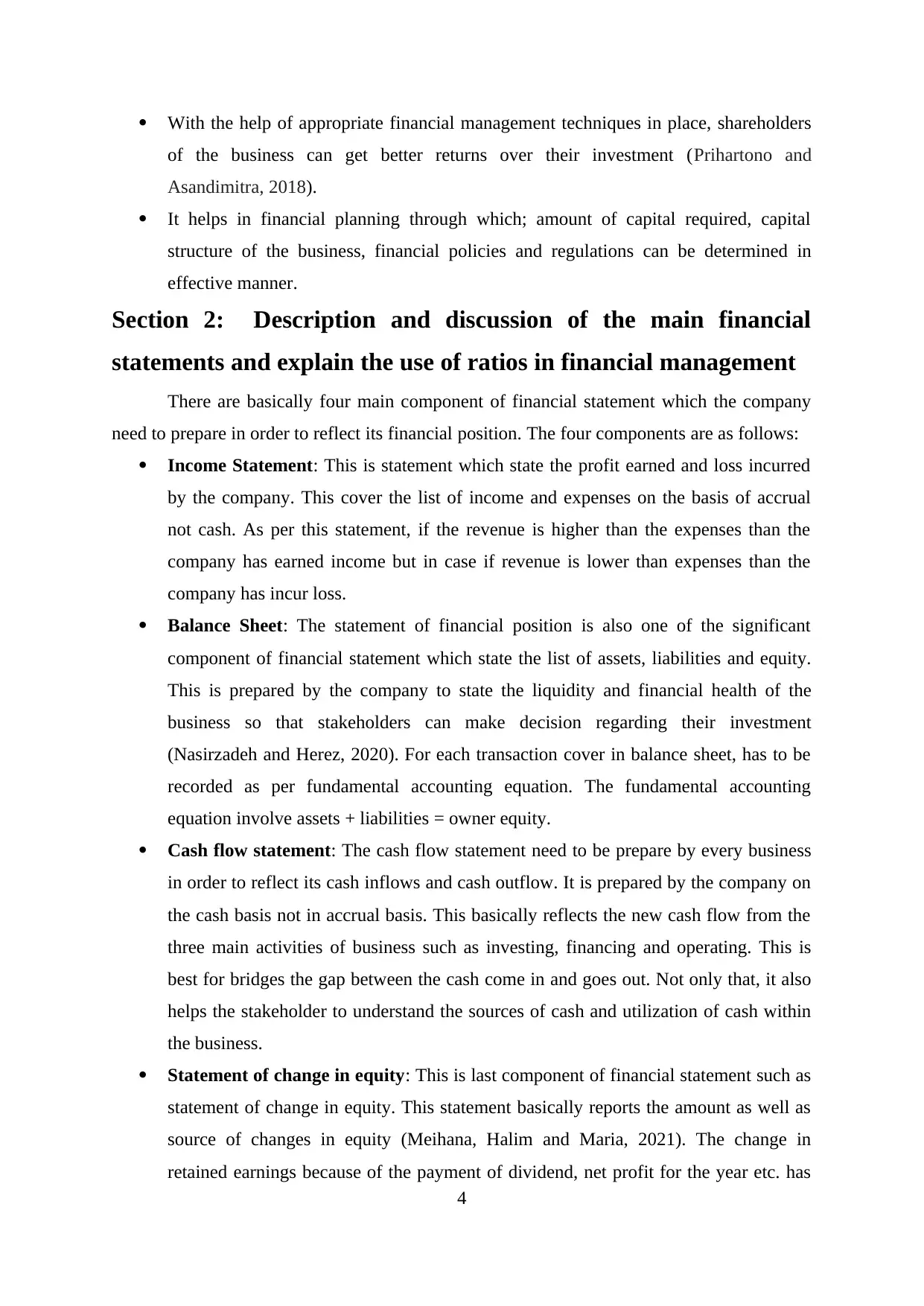
With the help of appropriate financial management techniques in place, shareholders
of the business can get better returns over their investment (Prihartono and
Asandimitra, 2018).
It helps in financial planning through which; amount of capital required, capital
structure of the business, financial policies and regulations can be determined in
effective manner.
Section 2: Description and discussion of the main financial
statements and explain the use of ratios in financial management
There are basically four main component of financial statement which the company
need to prepare in order to reflect its financial position. The four components are as follows:
Income Statement: This is statement which state the profit earned and loss incurred
by the company. This cover the list of income and expenses on the basis of accrual
not cash. As per this statement, if the revenue is higher than the expenses than the
company has earned income but in case if revenue is lower than expenses than the
company has incur loss.
Balance Sheet: The statement of financial position is also one of the significant
component of financial statement which state the list of assets, liabilities and equity.
This is prepared by the company to state the liquidity and financial health of the
business so that stakeholders can make decision regarding their investment
(Nasirzadeh and Herez, 2020). For each transaction cover in balance sheet, has to be
recorded as per fundamental accounting equation. The fundamental accounting
equation involve assets + liabilities = owner equity.
Cash flow statement: The cash flow statement need to be prepare by every business
in order to reflect its cash inflows and cash outflow. It is prepared by the company on
the cash basis not in accrual basis. This basically reflects the new cash flow from the
three main activities of business such as investing, financing and operating. This is
best for bridges the gap between the cash come in and goes out. Not only that, it also
helps the stakeholder to understand the sources of cash and utilization of cash within
the business.
Statement of change in equity: This is last component of financial statement such as
statement of change in equity. This statement basically reports the amount as well as
source of changes in equity (Meihana, Halim and Maria, 2021). The change in
retained earnings because of the payment of dividend, net profit for the year etc. has
4
of the business can get better returns over their investment (Prihartono and
Asandimitra, 2018).
It helps in financial planning through which; amount of capital required, capital
structure of the business, financial policies and regulations can be determined in
effective manner.
Section 2: Description and discussion of the main financial
statements and explain the use of ratios in financial management
There are basically four main component of financial statement which the company
need to prepare in order to reflect its financial position. The four components are as follows:
Income Statement: This is statement which state the profit earned and loss incurred
by the company. This cover the list of income and expenses on the basis of accrual
not cash. As per this statement, if the revenue is higher than the expenses than the
company has earned income but in case if revenue is lower than expenses than the
company has incur loss.
Balance Sheet: The statement of financial position is also one of the significant
component of financial statement which state the list of assets, liabilities and equity.
This is prepared by the company to state the liquidity and financial health of the
business so that stakeholders can make decision regarding their investment
(Nasirzadeh and Herez, 2020). For each transaction cover in balance sheet, has to be
recorded as per fundamental accounting equation. The fundamental accounting
equation involve assets + liabilities = owner equity.
Cash flow statement: The cash flow statement need to be prepare by every business
in order to reflect its cash inflows and cash outflow. It is prepared by the company on
the cash basis not in accrual basis. This basically reflects the new cash flow from the
three main activities of business such as investing, financing and operating. This is
best for bridges the gap between the cash come in and goes out. Not only that, it also
helps the stakeholder to understand the sources of cash and utilization of cash within
the business.
Statement of change in equity: This is last component of financial statement such as
statement of change in equity. This statement basically reports the amount as well as
source of changes in equity (Meihana, Halim and Maria, 2021). The change in
retained earnings because of the payment of dividend, net profit for the year etc. has
4
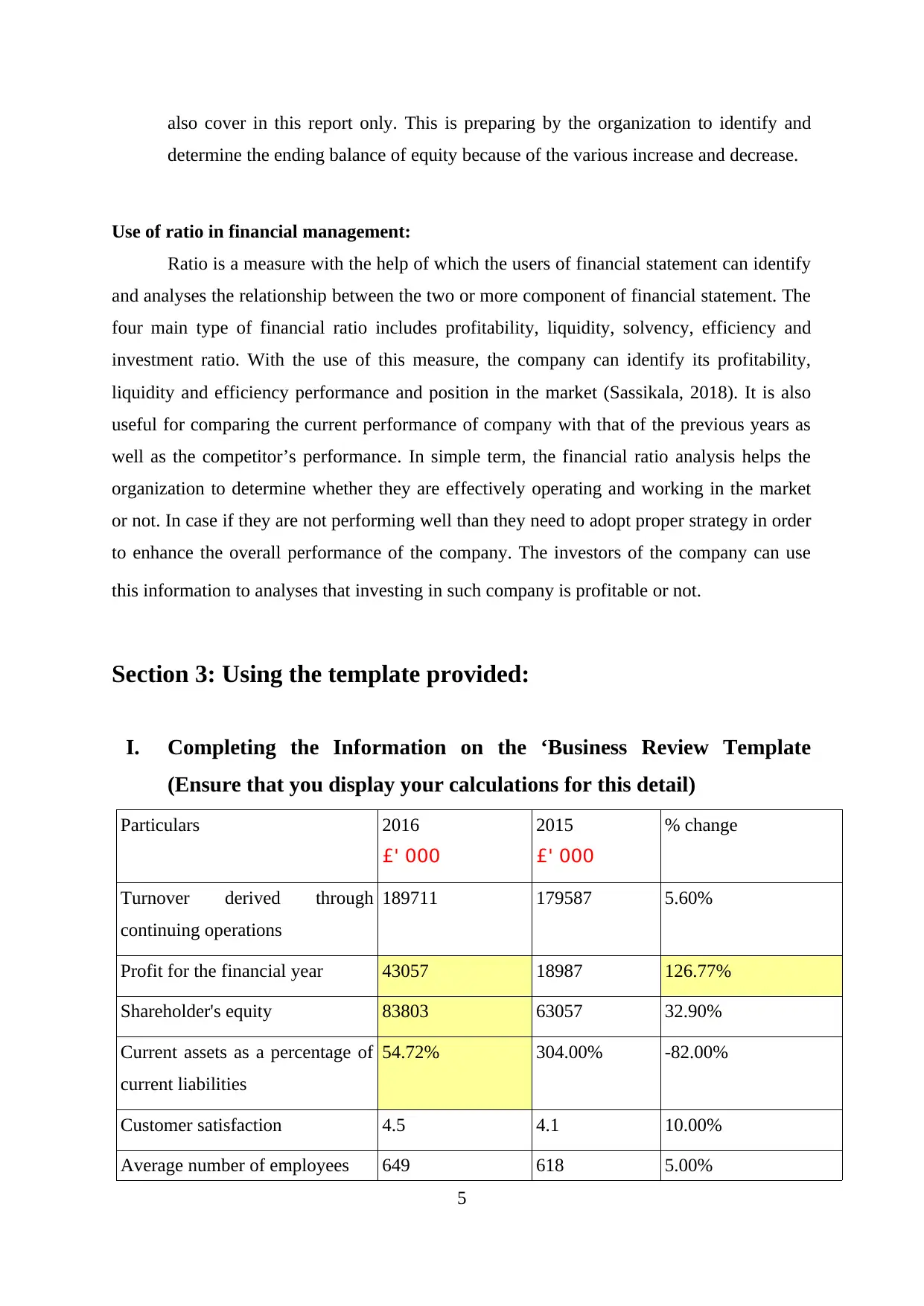
also cover in this report only. This is preparing by the organization to identify and
determine the ending balance of equity because of the various increase and decrease.
Use of ratio in financial management:
Ratio is a measure with the help of which the users of financial statement can identify
and analyses the relationship between the two or more component of financial statement. The
four main type of financial ratio includes profitability, liquidity, solvency, efficiency and
investment ratio. With the use of this measure, the company can identify its profitability,
liquidity and efficiency performance and position in the market (Sassikala, 2018). It is also
useful for comparing the current performance of company with that of the previous years as
well as the competitor’s performance. In simple term, the financial ratio analysis helps the
organization to determine whether they are effectively operating and working in the market
or not. In case if they are not performing well than they need to adopt proper strategy in order
to enhance the overall performance of the company. The investors of the company can use
this information to analyses that investing in such company is profitable or not.
Section 3: Using the template provided:
I. Completing the Information on the ‘Business Review Template
(Ensure that you display your calculations for this detail)
Particulars 2016
£' 000
2015
£' 000
% change
Turnover derived through
continuing operations
189711 179587 5.60%
Profit for the financial year 43057 18987 126.77%
Shareholder's equity 83803 63057 32.90%
Current assets as a percentage of
current liabilities
54.72% 304.00% -82.00%
Customer satisfaction 4.5 4.1 10.00%
Average number of employees 649 618 5.00%
5
determine the ending balance of equity because of the various increase and decrease.
Use of ratio in financial management:
Ratio is a measure with the help of which the users of financial statement can identify
and analyses the relationship between the two or more component of financial statement. The
four main type of financial ratio includes profitability, liquidity, solvency, efficiency and
investment ratio. With the use of this measure, the company can identify its profitability,
liquidity and efficiency performance and position in the market (Sassikala, 2018). It is also
useful for comparing the current performance of company with that of the previous years as
well as the competitor’s performance. In simple term, the financial ratio analysis helps the
organization to determine whether they are effectively operating and working in the market
or not. In case if they are not performing well than they need to adopt proper strategy in order
to enhance the overall performance of the company. The investors of the company can use
this information to analyses that investing in such company is profitable or not.
Section 3: Using the template provided:
I. Completing the Information on the ‘Business Review Template
(Ensure that you display your calculations for this detail)
Particulars 2016
£' 000
2015
£' 000
% change
Turnover derived through
continuing operations
189711 179587 5.60%
Profit for the financial year 43057 18987 126.77%
Shareholder's equity 83803 63057 32.90%
Current assets as a percentage of
current liabilities
54.72% 304.00% -82.00%
Customer satisfaction 4.5 4.1 10.00%
Average number of employees 649 618 5.00%
5
⊘ This is a preview!⊘
Do you want full access?
Subscribe today to unlock all pages.

Trusted by 1+ million students worldwide
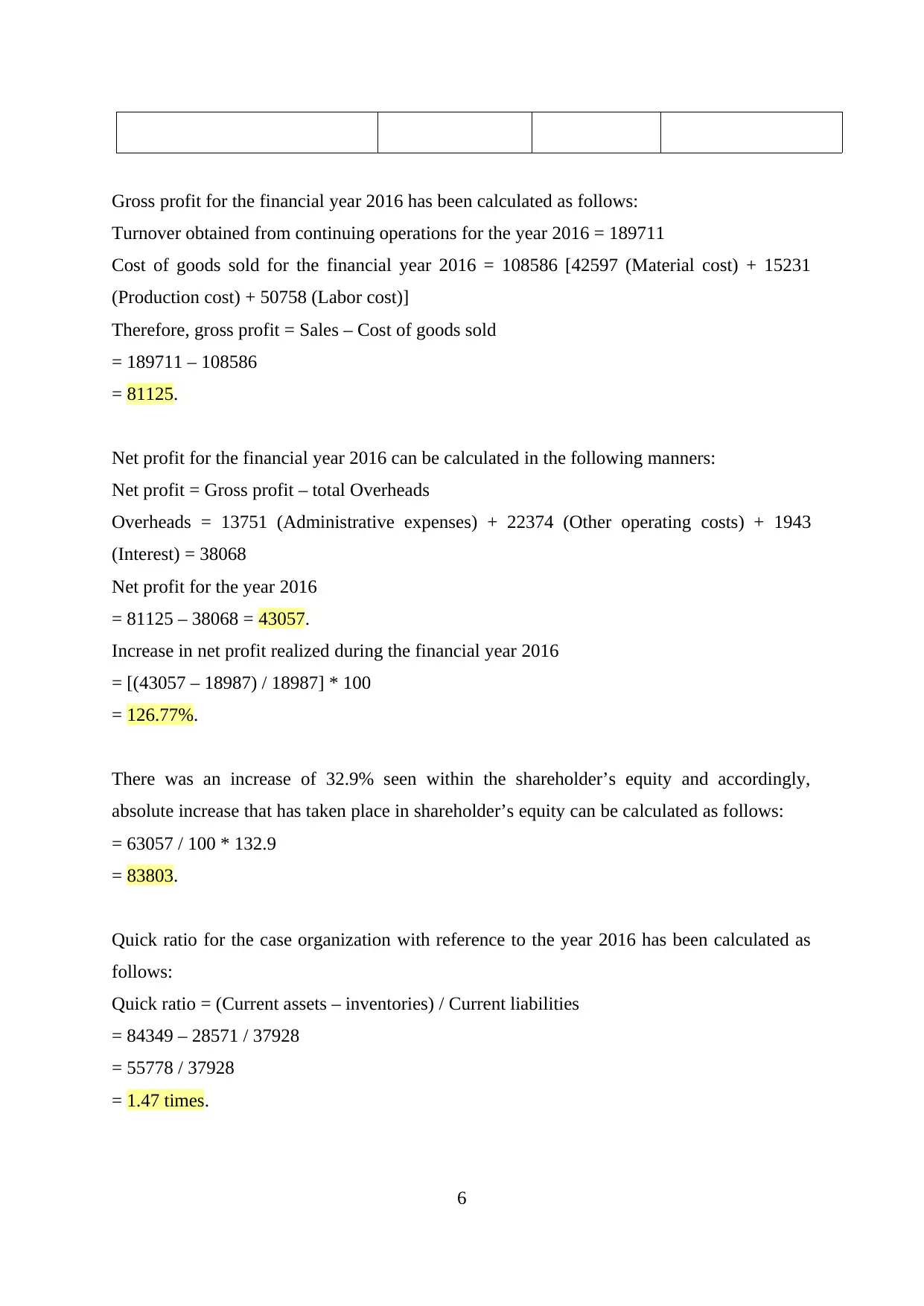
Gross profit for the financial year 2016 has been calculated as follows:
Turnover obtained from continuing operations for the year 2016 = 189711
Cost of goods sold for the financial year 2016 = 108586 [42597 (Material cost) + 15231
(Production cost) + 50758 (Labor cost)]
Therefore, gross profit = Sales – Cost of goods sold
= 189711 – 108586
= 81125.
Net profit for the financial year 2016 can be calculated in the following manners:
Net profit = Gross profit – total Overheads
Overheads = 13751 (Administrative expenses) + 22374 (Other operating costs) + 1943
(Interest) = 38068
Net profit for the year 2016
= 81125 – 38068 = 43057.
Increase in net profit realized during the financial year 2016
= [(43057 – 18987) / 18987] * 100
= 126.77%.
There was an increase of 32.9% seen within the shareholder’s equity and accordingly,
absolute increase that has taken place in shareholder’s equity can be calculated as follows:
= 63057 / 100 * 132.9
= 83803.
Quick ratio for the case organization with reference to the year 2016 has been calculated as
follows:
Quick ratio = (Current assets – inventories) / Current liabilities
= 84349 – 28571 / 37928
= 55778 / 37928
= 1.47 times.
6
Turnover obtained from continuing operations for the year 2016 = 189711
Cost of goods sold for the financial year 2016 = 108586 [42597 (Material cost) + 15231
(Production cost) + 50758 (Labor cost)]
Therefore, gross profit = Sales – Cost of goods sold
= 189711 – 108586
= 81125.
Net profit for the financial year 2016 can be calculated in the following manners:
Net profit = Gross profit – total Overheads
Overheads = 13751 (Administrative expenses) + 22374 (Other operating costs) + 1943
(Interest) = 38068
Net profit for the year 2016
= 81125 – 38068 = 43057.
Increase in net profit realized during the financial year 2016
= [(43057 – 18987) / 18987] * 100
= 126.77%.
There was an increase of 32.9% seen within the shareholder’s equity and accordingly,
absolute increase that has taken place in shareholder’s equity can be calculated as follows:
= 63057 / 100 * 132.9
= 83803.
Quick ratio for the case organization with reference to the year 2016 has been calculated as
follows:
Quick ratio = (Current assets – inventories) / Current liabilities
= 84349 – 28571 / 37928
= 55778 / 37928
= 1.47 times.
6
Paraphrase This Document
Need a fresh take? Get an instant paraphrase of this document with our AI Paraphraser
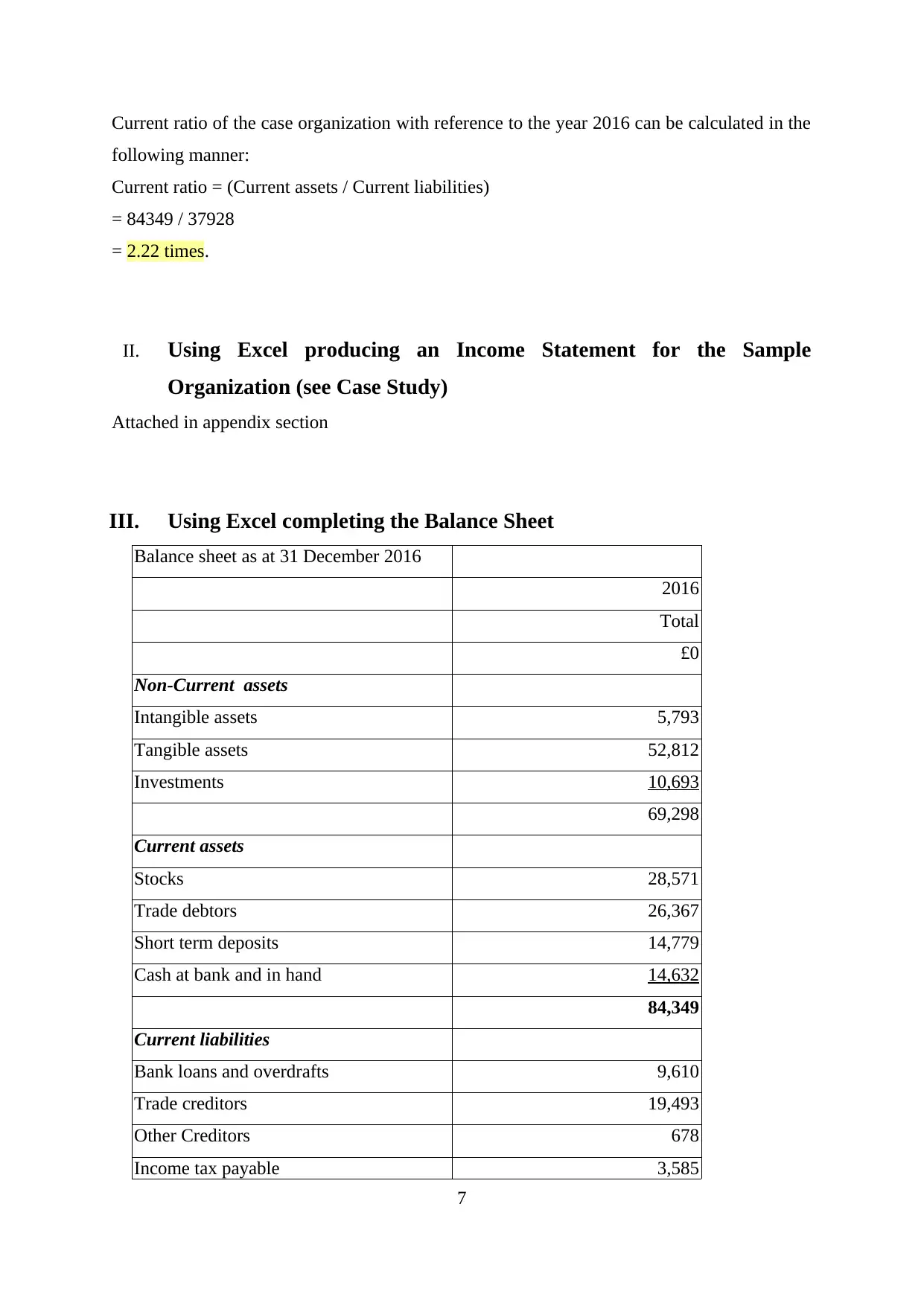
Current ratio of the case organization with reference to the year 2016 can be calculated in the
following manner:
Current ratio = (Current assets / Current liabilities)
= 84349 / 37928
= 2.22 times.
II. Using Excel producing an Income Statement for the Sample
Organization (see Case Study)
Attached in appendix section
III. Using Excel completing the Balance Sheet
Balance sheet as at 31 December 2016
2016
Total
£0
Non-Current assets
Intangible assets 5,793
Tangible assets 52,812
Investments 10,693
69,298
Current assets
Stocks 28,571
Trade debtors 26,367
Short term deposits 14,779
Cash at bank and in hand 14,632
84,349
Current liabilities
Bank loans and overdrafts 9,610
Trade creditors 19,493
Other Creditors 678
Income tax payable 3,585
7
following manner:
Current ratio = (Current assets / Current liabilities)
= 84349 / 37928
= 2.22 times.
II. Using Excel producing an Income Statement for the Sample
Organization (see Case Study)
Attached in appendix section
III. Using Excel completing the Balance Sheet
Balance sheet as at 31 December 2016
2016
Total
£0
Non-Current assets
Intangible assets 5,793
Tangible assets 52,812
Investments 10,693
69,298
Current assets
Stocks 28,571
Trade debtors 26,367
Short term deposits 14,779
Cash at bank and in hand 14,632
84,349
Current liabilities
Bank loans and overdrafts 9,610
Trade creditors 19,493
Other Creditors 678
Income tax payable 3,585
7
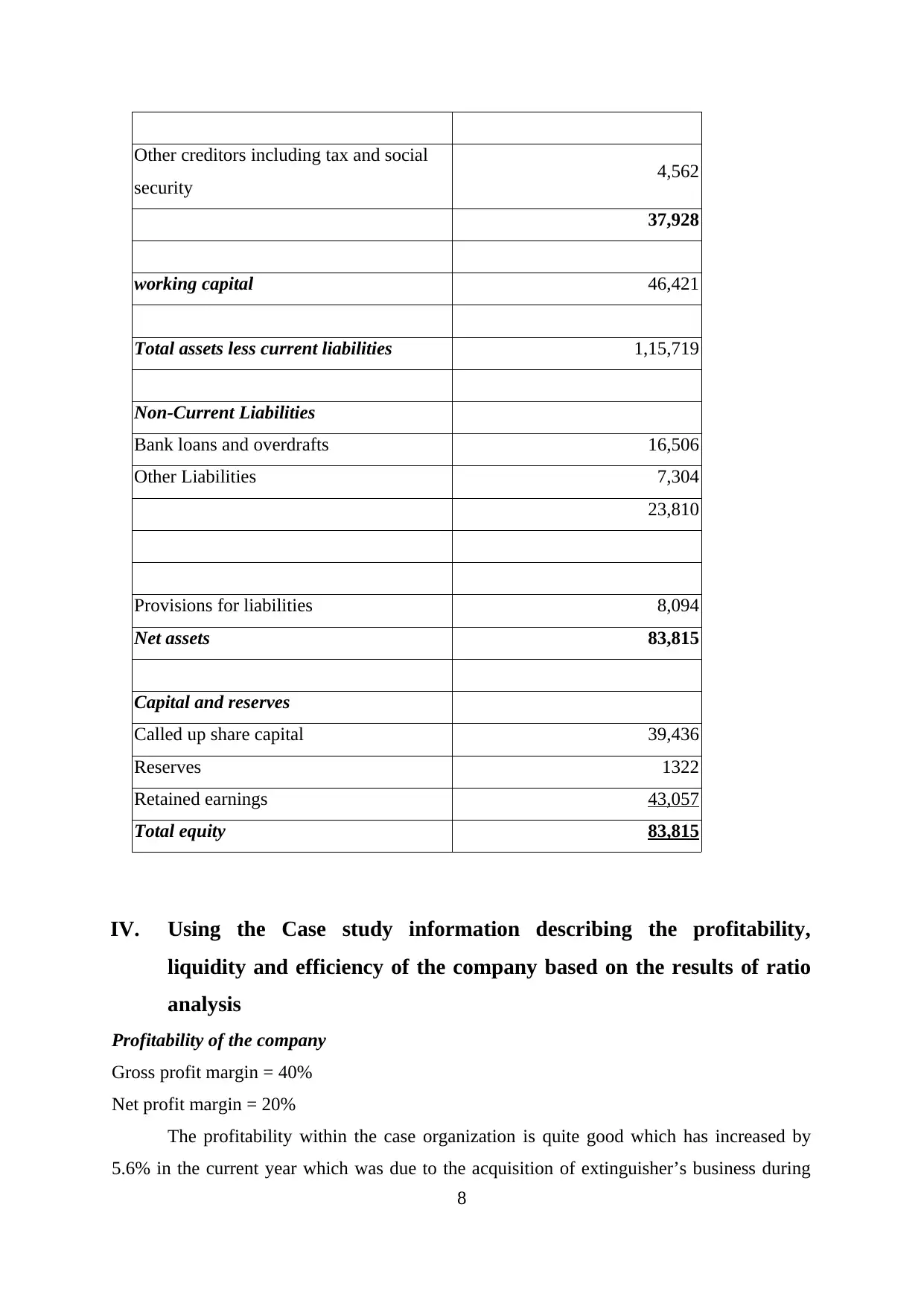
Other creditors including tax and social
security 4,562
37,928
working capital 46,421
Total assets less current liabilities 1,15,719
Non-Current Liabilities
Bank loans and overdrafts 16,506
Other Liabilities 7,304
23,810
Provisions for liabilities 8,094
Net assets 83,815
Capital and reserves
Called up share capital 39,436
Reserves 1322
Retained earnings 43,057
Total equity 83,815
IV. Using the Case study information describing the profitability,
liquidity and efficiency of the company based on the results of ratio
analysis
Profitability of the company
Gross profit margin = 40%
Net profit margin = 20%
The profitability within the case organization is quite good which has increased by
5.6% in the current year which was due to the acquisition of extinguisher’s business during
8
security 4,562
37,928
working capital 46,421
Total assets less current liabilities 1,15,719
Non-Current Liabilities
Bank loans and overdrafts 16,506
Other Liabilities 7,304
23,810
Provisions for liabilities 8,094
Net assets 83,815
Capital and reserves
Called up share capital 39,436
Reserves 1322
Retained earnings 43,057
Total equity 83,815
IV. Using the Case study information describing the profitability,
liquidity and efficiency of the company based on the results of ratio
analysis
Profitability of the company
Gross profit margin = 40%
Net profit margin = 20%
The profitability within the case organization is quite good which has increased by
5.6% in the current year which was due to the acquisition of extinguisher’s business during
8
⊘ This is a preview!⊘
Do you want full access?
Subscribe today to unlock all pages.

Trusted by 1+ million students worldwide
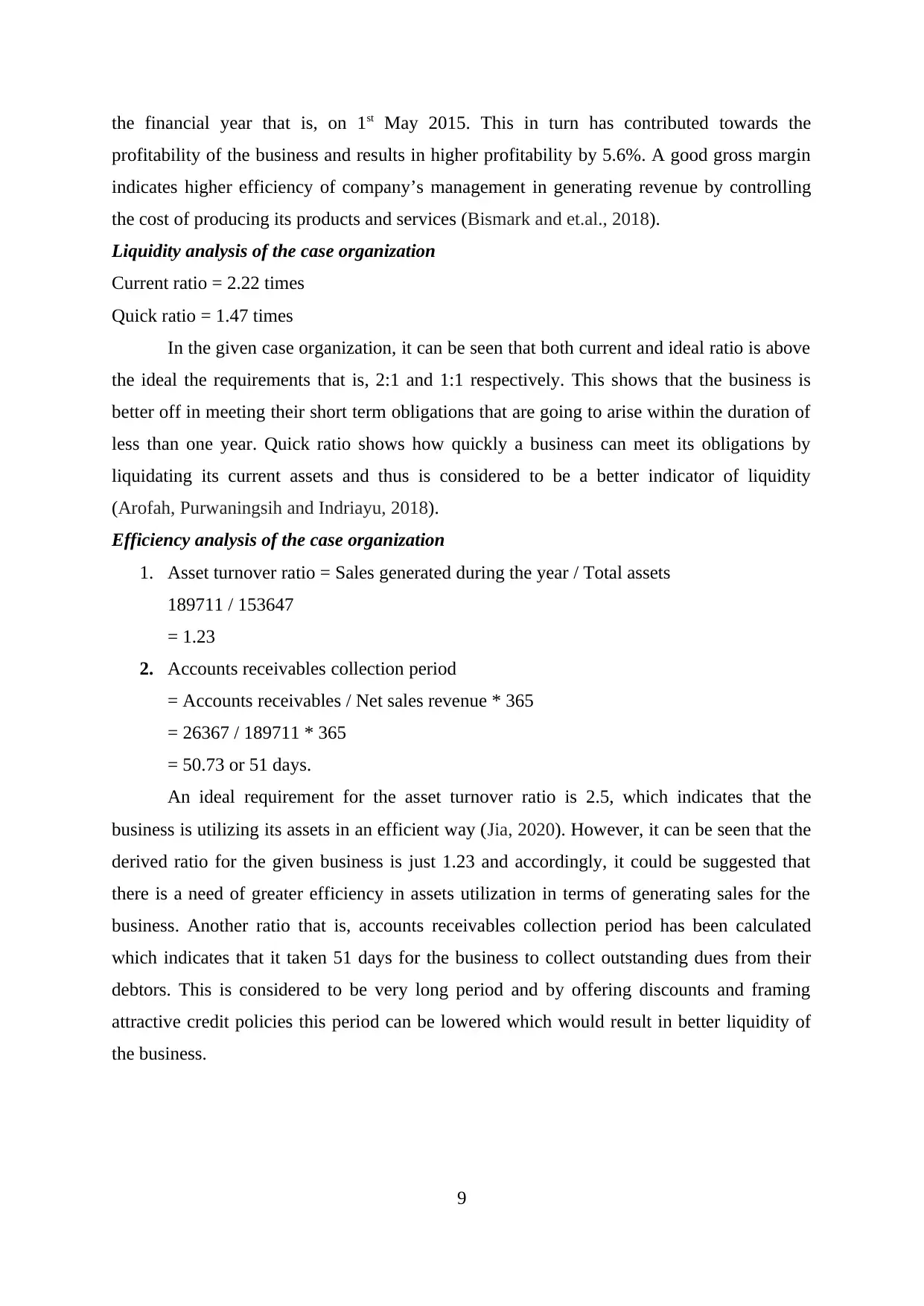
the financial year that is, on 1st May 2015. This in turn has contributed towards the
profitability of the business and results in higher profitability by 5.6%. A good gross margin
indicates higher efficiency of company’s management in generating revenue by controlling
the cost of producing its products and services (Bismark and et.al., 2018).
Liquidity analysis of the case organization
Current ratio = 2.22 times
Quick ratio = 1.47 times
In the given case organization, it can be seen that both current and ideal ratio is above
the ideal the requirements that is, 2:1 and 1:1 respectively. This shows that the business is
better off in meeting their short term obligations that are going to arise within the duration of
less than one year. Quick ratio shows how quickly a business can meet its obligations by
liquidating its current assets and thus is considered to be a better indicator of liquidity
(Arofah, Purwaningsih and Indriayu, 2018).
Efficiency analysis of the case organization
1. Asset turnover ratio = Sales generated during the year / Total assets
189711 / 153647
= 1.23
2. Accounts receivables collection period
= Accounts receivables / Net sales revenue * 365
= 26367 / 189711 * 365
= 50.73 or 51 days.
An ideal requirement for the asset turnover ratio is 2.5, which indicates that the
business is utilizing its assets in an efficient way (Jia, 2020). However, it can be seen that the
derived ratio for the given business is just 1.23 and accordingly, it could be suggested that
there is a need of greater efficiency in assets utilization in terms of generating sales for the
business. Another ratio that is, accounts receivables collection period has been calculated
which indicates that it taken 51 days for the business to collect outstanding dues from their
debtors. This is considered to be very long period and by offering discounts and framing
attractive credit policies this period can be lowered which would result in better liquidity of
the business.
9
profitability of the business and results in higher profitability by 5.6%. A good gross margin
indicates higher efficiency of company’s management in generating revenue by controlling
the cost of producing its products and services (Bismark and et.al., 2018).
Liquidity analysis of the case organization
Current ratio = 2.22 times
Quick ratio = 1.47 times
In the given case organization, it can be seen that both current and ideal ratio is above
the ideal the requirements that is, 2:1 and 1:1 respectively. This shows that the business is
better off in meeting their short term obligations that are going to arise within the duration of
less than one year. Quick ratio shows how quickly a business can meet its obligations by
liquidating its current assets and thus is considered to be a better indicator of liquidity
(Arofah, Purwaningsih and Indriayu, 2018).
Efficiency analysis of the case organization
1. Asset turnover ratio = Sales generated during the year / Total assets
189711 / 153647
= 1.23
2. Accounts receivables collection period
= Accounts receivables / Net sales revenue * 365
= 26367 / 189711 * 365
= 50.73 or 51 days.
An ideal requirement for the asset turnover ratio is 2.5, which indicates that the
business is utilizing its assets in an efficient way (Jia, 2020). However, it can be seen that the
derived ratio for the given business is just 1.23 and accordingly, it could be suggested that
there is a need of greater efficiency in assets utilization in terms of generating sales for the
business. Another ratio that is, accounts receivables collection period has been calculated
which indicates that it taken 51 days for the business to collect outstanding dues from their
debtors. This is considered to be very long period and by offering discounts and framing
attractive credit policies this period can be lowered which would result in better liquidity of
the business.
9
Paraphrase This Document
Need a fresh take? Get an instant paraphrase of this document with our AI Paraphraser
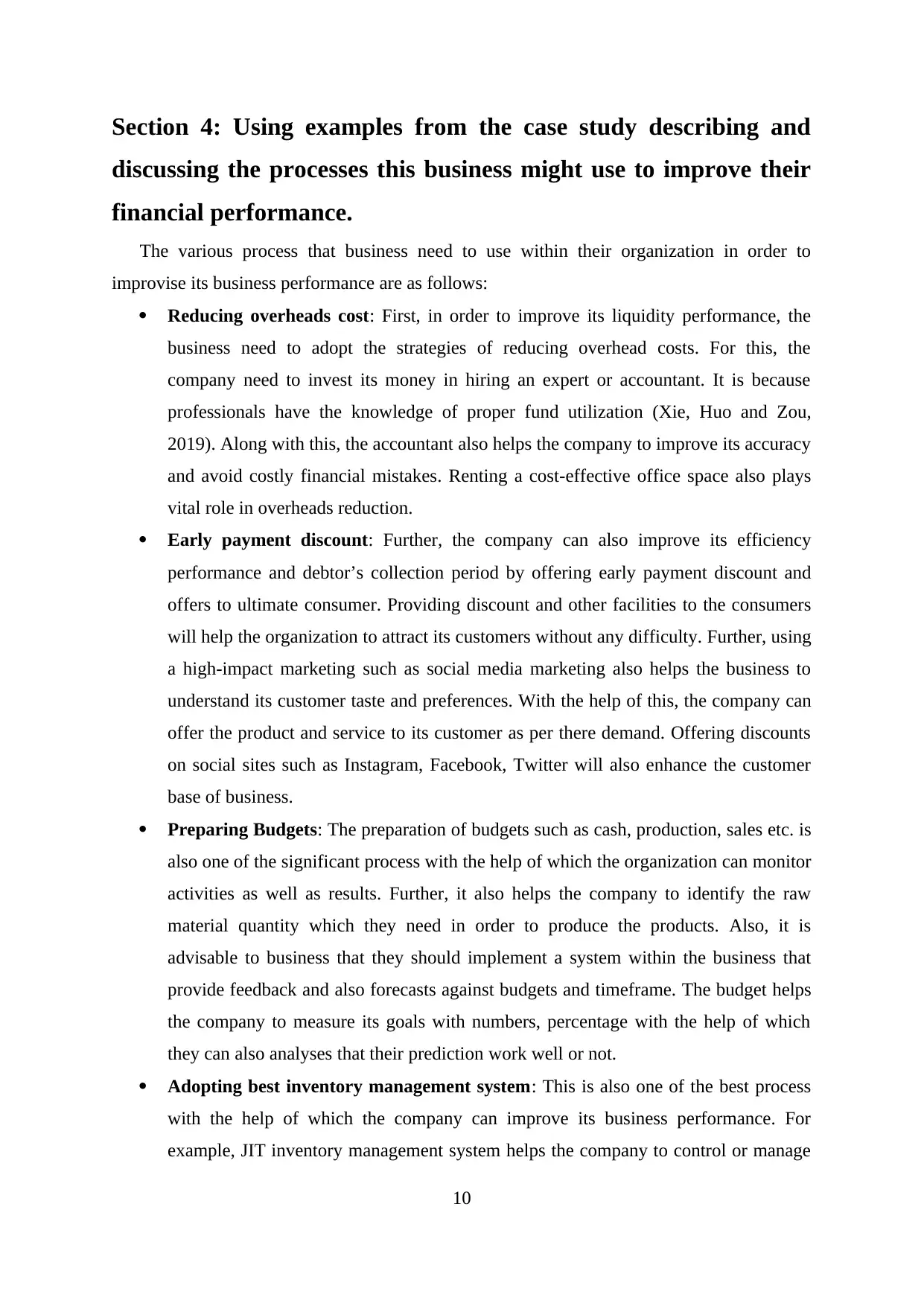
Section 4: Using examples from the case study describing and
discussing the processes this business might use to improve their
financial performance.
The various process that business need to use within their organization in order to
improvise its business performance are as follows:
Reducing overheads cost: First, in order to improve its liquidity performance, the
business need to adopt the strategies of reducing overhead costs. For this, the
company need to invest its money in hiring an expert or accountant. It is because
professionals have the knowledge of proper fund utilization (Xie, Huo and Zou,
2019). Along with this, the accountant also helps the company to improve its accuracy
and avoid costly financial mistakes. Renting a cost-effective office space also plays
vital role in overheads reduction.
Early payment discount: Further, the company can also improve its efficiency
performance and debtor’s collection period by offering early payment discount and
offers to ultimate consumer. Providing discount and other facilities to the consumers
will help the organization to attract its customers without any difficulty. Further, using
a high-impact marketing such as social media marketing also helps the business to
understand its customer taste and preferences. With the help of this, the company can
offer the product and service to its customer as per there demand. Offering discounts
on social sites such as Instagram, Facebook, Twitter will also enhance the customer
base of business.
Preparing Budgets: The preparation of budgets such as cash, production, sales etc. is
also one of the significant process with the help of which the organization can monitor
activities as well as results. Further, it also helps the company to identify the raw
material quantity which they need in order to produce the products. Also, it is
advisable to business that they should implement a system within the business that
provide feedback and also forecasts against budgets and timeframe. The budget helps
the company to measure its goals with numbers, percentage with the help of which
they can also analyses that their prediction work well or not.
Adopting best inventory management system: This is also one of the best process
with the help of which the company can improve its business performance. For
example, JIT inventory management system helps the company to control or manage
10
discussing the processes this business might use to improve their
financial performance.
The various process that business need to use within their organization in order to
improvise its business performance are as follows:
Reducing overheads cost: First, in order to improve its liquidity performance, the
business need to adopt the strategies of reducing overhead costs. For this, the
company need to invest its money in hiring an expert or accountant. It is because
professionals have the knowledge of proper fund utilization (Xie, Huo and Zou,
2019). Along with this, the accountant also helps the company to improve its accuracy
and avoid costly financial mistakes. Renting a cost-effective office space also plays
vital role in overheads reduction.
Early payment discount: Further, the company can also improve its efficiency
performance and debtor’s collection period by offering early payment discount and
offers to ultimate consumer. Providing discount and other facilities to the consumers
will help the organization to attract its customers without any difficulty. Further, using
a high-impact marketing such as social media marketing also helps the business to
understand its customer taste and preferences. With the help of this, the company can
offer the product and service to its customer as per there demand. Offering discounts
on social sites such as Instagram, Facebook, Twitter will also enhance the customer
base of business.
Preparing Budgets: The preparation of budgets such as cash, production, sales etc. is
also one of the significant process with the help of which the organization can monitor
activities as well as results. Further, it also helps the company to identify the raw
material quantity which they need in order to produce the products. Also, it is
advisable to business that they should implement a system within the business that
provide feedback and also forecasts against budgets and timeframe. The budget helps
the company to measure its goals with numbers, percentage with the help of which
they can also analyses that their prediction work well or not.
Adopting best inventory management system: This is also one of the best process
with the help of which the company can improve its business performance. For
example, JIT inventory management system helps the company to control or manage
10
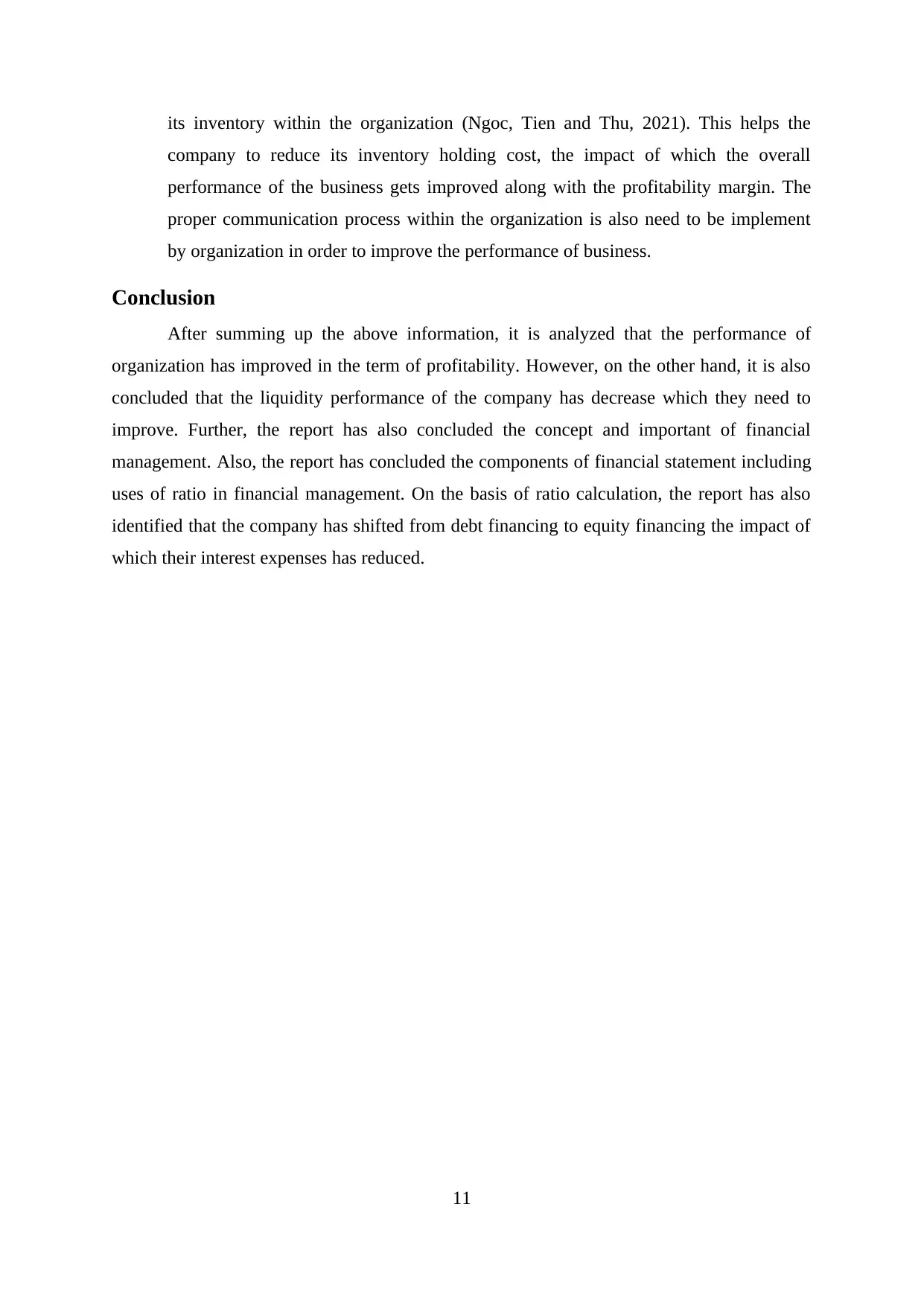
its inventory within the organization (Ngoc, Tien and Thu, 2021). This helps the
company to reduce its inventory holding cost, the impact of which the overall
performance of the business gets improved along with the profitability margin. The
proper communication process within the organization is also need to be implement
by organization in order to improve the performance of business.
Conclusion
After summing up the above information, it is analyzed that the performance of
organization has improved in the term of profitability. However, on the other hand, it is also
concluded that the liquidity performance of the company has decrease which they need to
improve. Further, the report has also concluded the concept and important of financial
management. Also, the report has concluded the components of financial statement including
uses of ratio in financial management. On the basis of ratio calculation, the report has also
identified that the company has shifted from debt financing to equity financing the impact of
which their interest expenses has reduced.
11
company to reduce its inventory holding cost, the impact of which the overall
performance of the business gets improved along with the profitability margin. The
proper communication process within the organization is also need to be implement
by organization in order to improve the performance of business.
Conclusion
After summing up the above information, it is analyzed that the performance of
organization has improved in the term of profitability. However, on the other hand, it is also
concluded that the liquidity performance of the company has decrease which they need to
improve. Further, the report has also concluded the concept and important of financial
management. Also, the report has concluded the components of financial statement including
uses of ratio in financial management. On the basis of ratio calculation, the report has also
identified that the company has shifted from debt financing to equity financing the impact of
which their interest expenses has reduced.
11
⊘ This is a preview!⊘
Do you want full access?
Subscribe today to unlock all pages.

Trusted by 1+ million students worldwide
1 out of 14
Related Documents
Your All-in-One AI-Powered Toolkit for Academic Success.
+13062052269
info@desklib.com
Available 24*7 on WhatsApp / Email
![[object Object]](/_next/static/media/star-bottom.7253800d.svg)
Unlock your academic potential
Copyright © 2020–2025 A2Z Services. All Rights Reserved. Developed and managed by ZUCOL.


